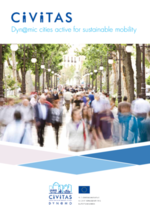Dynamic SUMP
Summary
Aachen’s SUMP consists of four elements: A vision mobility 2050, a mobility strategy 2030, a program 2022 and a status quo report. The main purpose has been to strengthen a partnership on city level amongst 140 people from administration, mobility providers, politicians, scientists and representatives of institutions. The public is invited to participate at selected times.
In addition, on regional level a growing cooperation has been established amongst the planners of the individual cities. Based on the traditional methodology of a regional transport model suitable forms have been tested to find a cooperative partnership between Aachen and the more rural cities in the neighbourhood.
Implementing sustainable mobility
The main objectives of this measure were:
- Establishment of eight thematic groups to pre-discuss important themes amongst all relevant stakeholders
- Development and political approval of a Vision Mobililty 2050, a Mobility Strategy 2030 and a programme until 2020 for the city of Aachen
- Identification of mobility themes to be planned on a regional level
- Establishment of suitable advisory board for regional mobility aspects to improve the chance of getting regional consensus for regional relevant measures
- Preparation of a regional SUMP
- Establishment of new forms of participation in the city of Aachen
Progress
In October 2012, eight thematic commissions were established in the City’s SUMP – a mixture of expert groups and cooperative stakeholder involvement:
- Four commissions for special aspects of the transport modes walking, cycling, public transport and car traffic
- Four commissions for mobility management, street design, electromobility and safety
In June 2013 a draft version of the Vision Mobility 2050 has been presented on posters at a one-day-participation event in the city centre, where 500 people participated. Afterwards 250 people took part in the online-participation. With little modifications the vision was unanimous approved in the mobility board of the city of Aachen in January 2014. A very well designed brochure was published in 2015.
Since October 2013 the mobility strategy 2030 has been under preparation. In June 2015 a poster presentation and online-participation were made available for 12 thematic strategies.
On regional level several workshops took place to clarify the role of the regional administration (StädteRegion Aachen), relevant regional mobility aspects, forms for an advisory board and the most important regional mobility measures.
In the city of Aachen and on the regional level political approvals for continual mobility surveys have been achieved and in 2016 the first national mobility survey took place.
Outcomes
Tangible outputs:
- Test of on-site and online participation for the city's SUMP
- Approval of a Vision Mobility 2050 on city level
- Brochure Vision Mobility 2015
- Approval of a Mobility Strategy 2030 on city level
- Two brochures with regional mobility indicators
- Representative mobility survey 2016
- List of regional relevant mobility themes
- Political decision about regional SUMP
Expected outcomes in the short- to medium-term:
- Establishment of a regional SUMP
- Establishment of a regional cooperation framework for mobility issues
- Increased amount of multimodal mobility offers in the city and the region
Expected outcomes in the mid- to long-term:
- Decrease of traffic-related CO2-emissions
- Increase of share of environmentally friendly modes
- Reduction of solo car use









